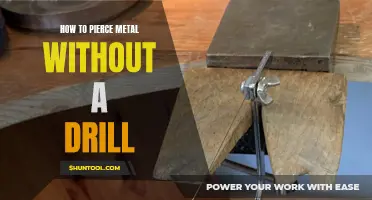
Have you ever wondered if it is possible to drill holes through acrylic sheets? Well, the answer is a resounding yes! Acrylic sheets are a versatile material that can be drilled to create holes for various purposes. Whether you want to install a shelf, mount a sign, or create a unique DIY project, drilling holes through acrylic sheets is an achievable task. In this guide, we will explore the necessary tools, techniques, and precautions to ensure a successful drilling experience. So, if you're ready to learn how to make precision holes in acrylic sheets, let's get started!
What You'll Learn
- What tools and equipment are needed to drill holes through acrylic sheets?
- Can any type of drill bit be used to drill holes through acrylic sheets?
- What safety precautions should be taken when drilling holes through acrylic sheets?
- Are there any special techniques or tips for drilling clean and precise holes in acrylic sheets?
- Are there any limitations or restrictions on the size or thickness of acrylic sheets that can be drilled?

What tools and equipment are needed to drill holes through acrylic sheets?
Drilling holes through acrylic sheets may seem like a daunting task, but with the right tools and equipment, it can be done safely and effectively. Whether you are working on a DIY project or a professional job, having the necessary tools and equipment is crucial for achieving precise and clean holes. In this article, we will discuss the key tools and equipment required for drilling holes through acrylic sheets, as well as provide step-by-step instructions on how to do it.
- Drill: The most important tool for drilling holes through acrylic sheets is a drill. When choosing a drill, it is important to select one that has a variable speed control and a high RPM (rotations per minute) range. This will allow you to adjust the speed according to the thickness of the acrylic sheet and prevent overheating. It is recommended to use a corded drill for better control and stability.
- Drill Bits: Acrylic sheets are relatively soft compared to other materials, so standard drill bits can be used. However, it is recommended to use high-speed steel (HSS) or carbide drill bits to ensure smoother and cleaner holes. The drill bits should have a sharp cutting edge and a point angle of 118 degrees, which is the standard for drilling through acrylic sheets. It is also important to select the right size of drill bit for the desired hole diameter.
- Clamps: To secure the acrylic sheet in place during drilling, clamps are essential. Use clamps with rubber inserts or padded jaws to prevent damage or scratches to the acrylic surface. Place the clamps on the edge of the sheet, ensuring a firm and stable grip.
- Lubricant or Coolant: When drilling through acrylic sheets, it is important to reduce heat buildup to prevent melting or cracking. Using a lubricant or coolant can help dissipate heat and reduce friction. A commonly used lubricant for acrylic drilling is water. You can either pour water over the drilling area manually or use a spray bottle to keep the area lubricated during the drilling process.
Step-by-Step Guide:
- Mark the Hole: Use a ruler or a measuring tape to mark the desired location of the hole on the acrylic sheet. Double-check the accuracy of the measurement before proceeding.
- Secure the Sheet: Place the acrylic sheet on a stable work surface and secure it with clamps. Make sure the sheet is firmly held to prevent any movement or slippage during drilling.
- Select the Drill Bit: Choose the appropriate drill bit size for the desired hole diameter. Insert the drill bit into the drill chuck and secure it tightly.
- Set the Speed: Adjust the drill speed to a suitable RPM range for drilling through acrylic. Start with a slower speed and increase gradually if needed, based on the thickness of the sheet.
- Start Drilling: Position the drill bit at the marked spot and apply gentle pressure to start drilling. Use a steady and controlled motion to avoid chipping or cracking the acrylic sheet. Keep the drill perpendicular to the sheet to ensure a straight hole.
- Use Coolant: If you notice the acrylic sheet heating up during drilling, apply a lubricant or coolant to the drilling area. This will help cool down the acrylic and prevent any damage.
- Complete the Hole: Continue drilling until the drill bit penetrates through the acrylic sheet. Take your time and maintain a constant speed to achieve a clean and precise hole.
- Remove Burrs: After drilling, you may notice small burrs or rough edges around the hole. Use a deburring tool or sandpaper to smooth out the edges and achieve a clean finish.
Remember to always wear safety glasses and gloves during the drilling process to protect yourself from flying debris. Additionally, it is recommended to practice on a scrap piece of acrylic sheet before working on a final project.
In conclusion, drilling holes through acrylic sheets requires the right tools and equipment. A drill with variable speed control, high-speed steel or carbide drill bits, clamps, and a lubricant or coolant are essential for achieving clean and precise holes. By following the step-by-step guide outlined above, you can confidently drill holes through acrylic sheets for your various projects.
Maximizing the Potential of Your Stanley Fatmax Drill: A Comprehensive Guide
You may want to see also

Can any type of drill bit be used to drill holes through acrylic sheets?
When it comes to drilling holes through acrylic sheets, choosing the right type of drill bit is crucial. Acrylic is a brittle material that can crack or chip easily if not drilled properly. Therefore, it is important to use the correct drill bit for the job to ensure clean and precise holes without damaging the acrylic.
The best type of drill bit to use for drilling holes through acrylic sheets is a twist drill bit with a high-speed steel (HSS) or carbide tip. These drill bits are specifically designed for cutting through various materials, including acrylic. They have a sharp cutting edge and can provide better control and accuracy during the drilling process.
Using a standard twist drill bit without a proper cutting edge can lead to cracking or chipping of the acrylic. For example, a masonry drill bit with a flat, blunt tip is not suitable for acrylic sheets as it can cause damage to the material. Similarly, a wood drill bit with its wide, deep flutes is not ideal as it can generate too much heat and potentially melt the acrylic.
To successfully drill holes through acrylic sheets, follow these step-by-step instructions:
- Mark the desired location of the hole on the acrylic sheet using a marker or tape. Make sure to measure and align the mark accurately.
- Set up your drilling equipment. Use a drill press or a hand drill with a variable speed control to ensure you have better control over the drilling process. Set the drill to a low speed setting.
- Put on safety goggles and gloves to protect yourself from any potential debris or sharp edges.
- Secure the acrylic sheet firmly in place. Place it on a sturdy surface such as a workbench and clamp it down to prevent it from moving during the drilling process. You can also place a scrap piece of wood beneath the acrylic sheet to prevent tear-out.
- Attach the appropriate drill bit to your drill. As mentioned earlier, a twist drill bit with a HSS or carbide tip is recommended.
- Position the drill bit at a 90-degree angle to the acrylic sheet, applying gentle pressure. Start drilling slowly and steadily. Allow the drill bit to do the work, avoiding excessive force or speed.
- Use a peck drilling technique for thicker acrylic sheets. This involves drilling a short distance, then retracting the drill bit to remove the accumulated chips. Repeat this process until you drill through the entire thickness of the acrylic.
- Apply a consistent amount of lubricant or coolant while drilling to prevent heat buildup. This will help maintain the integrity of the acrylic and prevent it from melting or cracking.
- Once the hole is drilled, remove the drill bit and inspect the hole. If there are any rough edges or burrs, use a deburring tool or sandpaper to smooth them out.
By using the correct drill bit and following these step-by-step instructions, you can safely drill holes through acrylic sheets without damaging the material. Remember to always take proper safety precautions and work in a well-ventilated area. With practice, you'll become more confident and skilled at drilling through acrylic sheets.
Mastering the Art of Setting Torque on a Cordless Drill: A Step-by-Step Guide
You may want to see also

What safety precautions should be taken when drilling holes through acrylic sheets?
When drilling holes through acrylic sheets, it is important to take several safety precautions to ensure a successful and safe process. Acrylic, also known as Plexiglas or acrylic glass, is a lightweight and durable material commonly used in various applications such as signage, displays, and crafts. However, it can be brittle and prone to cracking if not handled correctly. By following these safety precautions, you can minimize the risk of damaging the acrylic and ensure a clean and precise hole.
Wear Protective Gear:
Before beginning the drilling process, it is essential to wear appropriate protective gear. This includes safety goggles to protect your eyes from flying debris and acrylic shards. Additionally, wearing gloves will provide extra protection against potential injuries or cuts while handling the acrylic sheets.
Use the Correct Drill Bit:
The choice of drill bit is crucial when drilling through acrylic sheets. It is recommended to use a drill bit specifically designed for drilling acrylic or other plastics. These drill bits typically have a pointed tip and flutes that help reduce heat build-up and prevent the material from melting. Using the wrong type of drill bit, such as one designed for drilling metal or wood, can result in cracking or melting of the acrylic.
Mark the Hole:
Before drilling, mark the desired location of the hole on the acrylic sheet using a marker or a piece of tape. This will help guide you and ensure accurate placement of the hole. Double-check the measurements to avoid any mistakes that may result in a botched drilling attempt.
Secure the Acrylic Sheet:
To prevent the acrylic from cracking or splintering during drilling, it is crucial to secure it properly. Place the acrylic sheet on a stable and flat surface, such as a workbench or table. For added stability, you can use clamps or woodworking vises to hold the sheet securely in place, ensuring it doesn't move or vibrate during the drilling process.
Apply Steady Pressure:
When drilling through acrylic, it is important to apply steady and even pressure throughout the drilling process. Avoid applying excessive force, as this can lead to cracking or chipping of the material. Instead, maintain a consistent drilling speed and let the drill bit do the work. Slow and steady drilling prevents heat buildup and reduces the risk of melting the acrylic.
Use Lubrication:
To improve the drilling process and reduce heat build-up, consider using a lubricant. A small amount of water or a lubricant specifically designed for drilling plastics can help keep the drill bit cool and prevent the acrylic from melting or warping. Apply the lubricant to the drill bit before drilling or periodically while drilling to ensure smooth operation.
Be Mindful of Heat Build-up:
Heat build-up during drilling can cause acrylic to melt or warp. To prevent this, take frequent breaks during the drilling process to allow the material to cool down. This is especially important when drilling multiple holes or when working with thick acrylic sheets. Letting the drill bit cool down will help maintain the integrity of the material and prevent unnecessary damage.
Clean the Hole:
After drilling the hole, use a soft cloth or a deburring tool to remove any plastic debris or burrs from the edges. This will ensure a clean and smooth finish and prevent any potential injuries when handling the acrylic sheet.
By following these safety precautions, you can ensure a successful drilling process and maintain the integrity of the acrylic sheet. Always prioritize safety and take your time to achieve clean and precise holes when working with acrylic materials.
Is It Possible to Drill a Glu-Lam Beam?
You may want to see also

Are there any special techniques or tips for drilling clean and precise holes in acrylic sheets?
Drilling clean and precise holes in acrylic sheets can be a challenging task. Acrylic is a brittle material that is prone to cracking and chipping if not drilled properly. However, with the right techniques and tools, it is possible to achieve clean and precise holes without damaging the acrylic sheet. In this article, we will discuss some special techniques and tips for drilling acrylic sheets.
- Choose the right drill bit: When drilling acrylic, it is important to use a drill bit specifically designed for plastics. A standard twist drill bit can cause the acrylic to chip or crack. Instead, opt for a high-speed steel (HSS) or carbide-tipped drill bit with a sharp point. These types of drill bits have a flatter cutting edge, which helps prevent the acrylic from chipping.
- Mark the hole location: Before drilling, mark the exact location of the hole on the acrylic sheet. This will help ensure that the hole is drilled in the right place. You can use a permanent marker or a piece of masking tape to mark the spot.
- Secure the acrylic sheet: To prevent the acrylic sheet from moving or vibrating during drilling, it is important to secure it properly. Use clamps or double-sided tape to hold the sheet in place. This will provide stability and help achieve a clean and precise hole.
- Create a pilot hole: To prevent the drill bit from wandering and to create a starting point, it is recommended to create a pilot hole. Use a smaller-sized drill bit (about 1/8 inch) to create a small hole at the marked spot. This will help guide the larger drill bit when drilling the actual hole.
- Drill at a slow speed: Acrylic sheets can melt if the drill bit generates too much heat. To avoid this, drill at a slow speed. Set your drill to the lowest speed setting and apply gentle pressure. This will help prevent the acrylic from melting and create a cleaner hole.
- Use a lubricant: Using a lubricant while drilling can help reduce heat and friction. Apply a few drops of cutting fluid or a drop of dishwashing soap to the drill bit. This will act as a lubricant and make the drilling process smoother.
- Drill in stages: When drilling larger holes, it is recommended to drill in stages. Start with a smaller-sized drill bit and gradually increase the size until the desired hole size is achieved. This will reduce the chances of the acrylic sheet cracking or chipping.
- Support the backside: When drilling all the way through an acrylic sheet, it is important to support the backside to prevent it from cracking or splintering. Place a scrap piece of wood or plastic underneath the sheet to provide support. This will also help prevent tear-out on the backside of the hole.
- Clean the edges: After drilling the hole, it is important to clean the edges. Use a deburring tool or a countersink bit to remove any burrs or rough edges. This will give the hole a clean and finished look.
In conclusion, drilling clean and precise holes in acrylic sheets requires careful attention to detail and the use of the right tools and techniques. By following the steps mentioned above, you can successfully drill holes in acrylic without damaging the material. Remember to choose the right drill bit, secure the sheet properly, drill at a slow speed, and clean the edges for a professional finish.
The Cost of Drilling a Well in Mason County, WA
You may want to see also

Are there any limitations or restrictions on the size or thickness of acrylic sheets that can be drilled?
Acrylic sheets are a popular material for various applications, ranging from signage and display cases to windows and protective barriers. When working with acrylic sheets, one common task is drilling holes for mounting, hanging, or fastening purposes. However, there may be certain limitations or restrictions on the size or thickness of acrylic sheets that can be drilled. In this article, we will explore these limitations and offer some guidelines for drilling acrylic sheets.
Size and Thickness Limitations:
When it comes to drilling acrylic sheets, both size and thickness can impact the drilling process. Firstly, the size of the hole you want to drill should be considered. Acrylic sheets can be drilled with holes of various sizes, but it is generally recommended to drill holes with a diameter of at least 1/8 inch or larger. Smaller holes may be prone to cracking or chipping, especially if they are close to the edge of the sheet.
Secondly, the thickness of the acrylic sheet can also affect the drilling process. Thicker acrylic sheets may require more care and attention during drilling to prevent cracking or damaging the material. As a general rule of thumb, it is recommended to use a slower drill speed and apply less pressure when drilling thicker acrylic sheets.
Steps to Drill Acrylic Sheets:
To drill acrylic sheets safely and effectively, follow these step-by-step instructions:
- Gather the necessary tools: You will need a drill, drill bits suitable for acrylic (such as high-speed steel or carbide-tipped bits), a clamp or vise to secure the acrylic sheet, masking tape, and safety goggles.
- Mark the drilling locations: Use a ruler or measuring tape to mark the desired drilling locations on the acrylic sheet. Make sure the marks are clear and accurately placed.
- Secure the acrylic sheet: Place the acrylic sheet on a stable surface and secure it in place using a clamp or vise. This will prevent the sheet from moving or vibrating during the drilling process.
- Apply masking tape: To minimize the risk of chipping or cracking, apply masking tape over the marked drilling locations. This will help protect the surrounding area and provide additional support during drilling.
- Start drilling: Position the drill bit over the first marked hole and align it with the intended drilling angle. Start the drill at a low speed and gradually increase the speed as you progress. Apply steady and even pressure while drilling, but be careful not to push too hard, especially with thicker sheets.
- Remove the masking tape: Once the hole is drilled, carefully remove the masking tape from the acrylic sheet. This will reveal a clean and smooth hole without any chipping or damage.
- Repeat the process: If you need to drill multiple holes, repeat steps 4 to 6 for each hole, ensuring proper alignment and technique.
Examples:
For example, let's say you have a 1/4 inch thick acrylic sheet and need to drill a 1/2 inch diameter hole for mounting purposes. Following the guidelines mentioned above, you would use a drill bit suitable for acrylic and start drilling at a low speed, gradually increasing the speed. By applying steady pressure and using masking tape for added support, you can safely drill the hole without damaging the acrylic sheet.
In another scenario, if you have a very thick acrylic sheet, such as 1 inch or more, you may need to use special drilling techniques and equipment. It is recommended to consult with an experienced professional or acrylic supplier for guidance in drilling thick acrylic sheets.
In conclusion, while there may be some limitations and restrictions on the size or thickness of acrylic sheets that can be drilled, following the proper drilling techniques and guidelines can help you safely and effectively drill holes in acrylic sheets of various sizes and thicknesses. By taking the necessary precautions, you can avoid cracking, chipping, or damaging the acrylic sheet and achieve clean and precise holes for your intended applications.
Easy Steps to Remove the Screw from a Keyed Drill Chuck
You may want to see also
Frequently asked questions
Yes, you can drill holes through acrylic sheets using a regular drill. However, it is important to use a sharp drill bit specifically designed for plastic materials to ensure clean and precise holes. Acrylic is a relatively soft material, so drilling slowly and applying gentle pressure will help prevent any cracking or shattering.
For drilling holes in acrylic sheets, it is recommended to use a drill bit specifically designed for plastics or a carbide-tipped drill bit. These types of drill bits are designed to minimize the risk of cracking or chipping the acrylic during the drilling process. Additionally, it is important to choose a drill bit with a size appropriate for the hole you need to create.
When drilling through acrylic sheets, it is important to take a few precautions to prevent damage to the material. First, it is advisable to clamp the acrylic securely to a work table or use a drill press to ensure stability during the drilling process. Second, using a low drill speed and applying light, constant pressure will reduce the risk of cracking or shattering the acrylic. Lastly, it is essential to wear safety goggles and a face mask to protect yourself from any flying debris.







